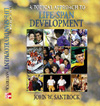 |  Life-Span Development: A Topical Approach John W. Santrock
Biological Process, Physical Development, and Health Health
Learning Objectives1.Describe how the biopsychosocial model combines biological, psychological, and social factors to understand health. |
 |  |  | 2.Discuss the focus in children's health on prevention and poverty, and the roles of immunization and accident prevention. |
 |  |  | 3.Explain how adolescence is seen as a critical junction in health, particularly with respect to the formation of good or bad health habits and the underutilization of health services by adolescents. |
 |  |  | 4.Consider the various aspects of adult health and aging, including:- How failure of young adults to understand their personal lifestyles will affect their later health, particularly since few young adults have health problems.
- The increase in chronic disorders as we age, especially osteoporosis for women and dementias (especially Alzheimer's) for older adults.
- The good news that a sizeable portion of older adults do not have disabilities and are more physically robust than previously thought.
- Special concerns about the quality of nursing homes for older adults and how older adults are treated by the medical community.
- The occurrence of accidents as the leading cause of death in infancy through young adulthood, whereas chronic diseases are the main causes of death in middle-aged and older adults.
|
 |  |  | 5.Explore the relationship between stress and health, looking at:- The physical and biological, personality, cognitive, environmental, and sociocultural factors involved in stress.
- The role that adaptive strategies, such as effective coping, optimism, self-efficacy, and social support play in weathering stress.
- Despite a lack of developmental focus of much of the theory and research on stress and coping, one area that does fit is the link between hormonal production and stress.
|
 |  |  | 6.Understand the roles of nutrition and eating behavior in health, particularly:- The importance of adequate energy intake consumed in a loving and supportive environment in infancy, why breast-feeding is usually recommended over bottle-feeding, and why malnutrition in early life is a problem.
- How nutritional concerns for children center around fat intake and obesity, whereas important concerns in adolescence are anorexia nervosa and bulimia nervosa.
- The issues of obesity and dieting in adulthood, the seemingly paradoxical finding that while food restriction is associated with longevity, a balanced diet is usually recommended for older adults, and the growing vitamin controversy.
|
 |  |  | 7.Discuss the concerns that children and adolescents are not getting enough exercise, although exercise has clear physical benefits at all ages. |
 |  |  | 8.Consider the causes of, and the problems inherent in, substance use and addiction, such as:- U.S. adolescents have the highest rate of substance use of any industrialized nation; consumption of alcohol and cigarettes are special concerns; early drug use poses detrimental long-term effects; and parents, peers, and social support are critical for preventing drug abuse.
- The high rate of alcoholism in the United States, the major health problem of cigarette smoking, and why it is so difficult to quit smoking.
- The two views of addiction: the disease model and the life-process model.
|
|



 2002 McGraw-Hill Higher Education
2002 McGraw-Hill Higher Education